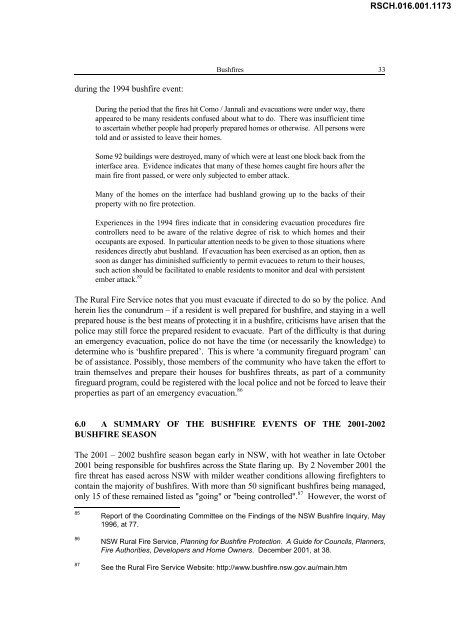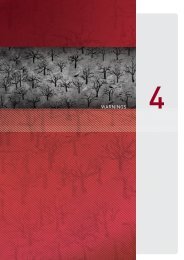RSCH.016.001.1136 - 2009 Victorian Bushfires Royal Commission
RSCH.016.001.1136 - 2009 Victorian Bushfires Royal Commission
RSCH.016.001.1136 - 2009 Victorian Bushfires Royal Commission
You also want an ePaper? Increase the reach of your titles
YUMPU automatically turns print PDFs into web optimized ePapers that Google loves.
RSCH.016.001.1173<br />
<strong>Bushfires</strong> 33<br />
during the 1994 bushfire event:<br />
During the period that the fires hit Como / Jannali and evacuations were under way, there<br />
appeared to be many residents confused about what to do. There was insufficient time<br />
to ascertain whether people had properly prepared homes or otherwise. All persons were<br />
told and or assisted to leave their homes.<br />
Some 92 buildings were destroyed, many of which were at least one block back from the<br />
interface area. Evidence indicates that many of these homes caught fire hours after the<br />
main fire front passed, or were only subjected to ember attack.<br />
Many of the homes on the interface had bushland growing up to the backs of their<br />
property with no fire protection.<br />
Experiences in the 1994 fires indicate that in considering evacuation procedures fire<br />
controllers need to be aware of the relative degree of risk to which homes and their<br />
occupants are exposed. In particular attention needs to be given to those situations where<br />
residences directly abut bushland. If evacuation has been exercised as an option, then as<br />
soon as danger has diminished sufficiently to permit evacuees to return to their houses,<br />
such action should be facilitated to enable residents to monitor and deal with persistent<br />
ember attack. 85<br />
The Rural Fire Service notes that you must evacuate if directed to do so by the police. And<br />
herein lies the conundrum – if a resident is well prepared for bushfire, and staying in a well<br />
prepared house is the best means of protecting it in a bushfire, criticisms have arisen that the<br />
police may still force the prepared resident to evacuate. Part of the difficulty is that during<br />
an emergency evacuation, police do not have the time (or necessarily the knowledge) to<br />
determine who is ‘bushfire prepared’. This is where ‘a community fireguard program’ can<br />
be of assistance. Possibly, those members of the community who have taken the effort to<br />
train themselves and prepare their houses for bushfires threats, as part of a community<br />
fireguard program, could be registered with the local police and not be forced to leave their<br />
properties as part of an emergency evacuation. 86<br />
6.0 A SUMMARY OF THE BUSHFIRE EVENTS OF THE 2001-2002<br />
BUSHFIRE SEASON<br />
The 2001 – 2002 bushfire season began early in NSW, with hot weather in late October<br />
2001 being responsible for bushfires across the State flaring up. By 2 November 2001 the<br />
fire threat has eased across NSW with milder weather conditions allowing firefighters to<br />
contain the majority of bushfires. With more than 50 significant bushfires being managed,<br />
only 15 of these remained listed as "going" or "being controlled". 87 However, the worst of<br />
85<br />
86<br />
87<br />
Report of the Coordinating Committee on the Findings of the NSW Bushfire Inquiry, May<br />
1996, at 77.<br />
NSW Rural Fire Service, Planning for Bushfire Protection. A Guide for Councils, Planners,<br />
Fire Authorities, Developers and Home Owners. December 2001, at 38.<br />
See the Rural Fire Service Website: http://www.bushfire.nsw.gov.au/main.htm
















